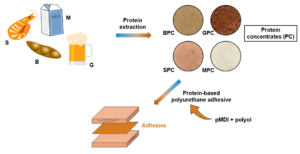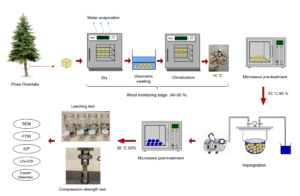Research Articles
Latest articles
- Researchpp 1079-1106Zhang, H., and Wu, J. (2024). “Optimization of potassium hydroxide combined urea pretreatment and enzymatic hydrolysis of wheat straw using response surface methodology for improving sugar production,” BioResources 19(1), 1079-1106.AbstractArticlePDF
To improve sugar yields from wheat straw (WS), response surface methodology (RSM) was adopted to optimize potassium hydroxide combined urea pretreatment and enzymatic hydrolysis of WS. Glucose and xylose yields from the pretreated WS were used as responses during the whole optimization. Potassium hydroxide concentration, time and temperature during pretreatment were found to have significant effects on sugar yields. Sugar yields could be enhanced while WS was pretreated using 45 g/L potassium hydroxide solution containing 15 g/L urea with solid to liquid ratio of 1:5 (g/mL) at 74.0 °C for 50 min. Cellulose recovery, hemicellulose recovery, and lignin removal after optimization were 98.1%, 72.6%, and 75.8%, respectively. In addition, enzyme loading, biomass loading, and reaction time during enzymatic hydrolysis also had significant effects on sugar yields. Maximal yields of glucose (610.25 mg/gds, miligram per gram dry substrate) and xylose (221.26 mg/gds) could be achieved while hydrolysis was carried out at 50 °C for 32.8 h with 141 g/L of biomass loading, 8.1 FPU/gds (filter paper activity unit per gram dry substrate) of enzyme loading and 0.4% (w/v) of polysorbate 80. The corresponding cellulose conversion and hemicellulose conversion were 97.2% and 90.4%, respectively.
- Researchpp 1107-1118Mageshwaran, V., Satankar, V., and Paul, S. (2024). “Solid-state fermentation for gossypol detoxification and nutritive enrichment of cottonseed cake: A scale-up of batch fermentation process,” BioResources 19(1), 1107-1118.AbstractArticlePDF
Gossypol, a toxic polyphenolic compound, limits the use of cottonseed cake (CSC) in animal feed. Different approaches have been employed to detoxify gossypol and improve the nutritive properties of feed. Microbial fermentation improves the nutritive quality of CSC by increasing lysine content and reducing free and bound gossypol. In this study, microbial fermentation was scaled up under batch conditions using a prototype device at the capacity of 40 kg per day. The mixed fungal culture C. tropicalis + S. cerevisiae was used for fermentation. An industrial trial was taken to ascertain the gossypol detoxification efficiency. The fermented CSC obtained under scale-up process had 60 to 80% and 40 to 60% reduction of free and bound gossypol, respectively, compared with raw CSC. The fermented CSC demonstrated an increase in crude protein (4 to 12%) and lysine (0.3 to 0.4%) and decrease in crude fibre (3 to 11%). The fermented CSC met the standards of US Food and Drug Administration in terms of its nutritional property. Thus, the simple method described in this study could be adopted for the production of detoxified CSC for use in the animal feed industry.
- Researchpp 1119-1135Chandramohan, P., Kalimuthu, M., Subramanian, K., Nagarajan, R., Muhammed, F. F., Al-Lohedan, H. A., and Krishnan, K. (2024). “Mechanical and thermo-mechanical behaviors of snake grass fiber-reinforced epoxy composite,” BioResources 19(1), 1119-1135.AbstractArticlePDF
Snake grass fiber was used as a supporting material in an epoxy matrix. The goal was to develop a lightweight structural material. To enhance the interfacial bonding between the snake grass (Sansevieria ehrenbergii) fiber and polymer matrices, the fiber underwent chemical treatment with NaOH. Samples were prepared with both neat and treated fibers mixed with epoxy at various volume percentages. The mechanical properties of snake grass fiber exhibited improvement with increasing fiber length and fixation, reaching optimal values at 20 mm length and 20% v/v fixation. Dynamic mechanical analysis (DMA) demonstrated superior energy absorption by the composite up to 140 °C, irrespective of repetition. Thermogravimetric analysis (TGA) indicated rapid degradation of untreated fiber with a residue level of 0.2%, while the snake grass composite (25% v/v) exhibited stable residue content at 11%. Microscopic evaluation using a scanning electron microscope provided insights into the morphology of the fiber surface.
- Researchpp 1136-1149Sampaio, J. d. S., Andrade, F. W. C., Moutinho, V. H. P., Santos, M. R. P., and Ferreira, J. S. d. S. (2024). “Crystallinity and chemical structure of Amazon wood species in a log yard after natural degradation,” BioResources 19(1), 1136-1149.AbstractArticlePDF
The objective of this work was to evaluate whether the chemical composition of wood and its crystallinity can help in the analysis of degradation by fungi and insects in logs of Amazonian wood species stored in a stockyard. For this study, wood from five commercial species that had been stored in an open yard for six months was used. The scale of degradation by fungi and insects, the moisture content of the logs, the total extractive content, lignin, holocellulose and the crystallinity were evaluated. It was concluded that the position of the logs in the stacks, associated with the storage time, influenced the evaluated characteristics. It was also observed that X-ray diffraction has potential for analysis of the degradation by fungi and insects in logs of Amazonian species stored in the stockyard.
- Researchpp 1150-1164Smith, M. M., Zambrano, M., Ankeny, M., Daystar, J., Pires, S., Pawlak, J., and Venditti, R. A. (2024). “Aquatic aerobic biodegradation of commonly flushed materials in aerobic wastewater treatment plant solids, seawater, and lakewater,” BioResources 19(1), 1150-1164.AbstractArticlePDF
Microfibers and microplastics originating from wastewater treatment plant (WWTP) effluents are significant pollutants in freshwater sources and marine environments. This research investigated the biodegradation of cotton microfibers generated from bleached cotton jersey knit fabric and commercially available flushable wipes, polypropylene-based (PP) nonwoven wipes containing a cellulose component, and tissue paper. Biodegradation was tested in wastewater treatment plants (WWTP) solids, seawater, and lakewater according to the ISO 14852 and ASTM D6691 standard methods in an ECHO respirometer. Degradation experiments continued until a plateau in CO2 emissions was reached, and the final biodegradation extent was calculated relative to the theoretical CO2 produced based on elemental analysis. The results showed that the cotton and other cellulosic materials/components biodegrade to a great extent, as expected for all conditions, whereas the PP did not degrade. In general, for the cellulose polypropylene composite wipes, the cellulose biodegraded readily; the presence of the PP did not hinder the cellulose biodegradation.
- Researchpp 1165-1189Mary, A., Blanchet, P., Pepin, S., Chamberland, J., and Landry, V. (2024). “Upcycling of protein concentrates from industrial byproducts into polyurethane wood adhesives,” BioResources 19(1), 1165-1189.AbstractArticlePDF

Wood structures generally rely on synthetic adhesives for their strength and versatility. However, environmental concerns linked to the chemical composition of these adhesives have stimulated the search for more environmentally friendly adhesives. Researchers have explored replacing petroleum-based constituents with natural raw materials such as lignins, tannins, and proteins. Of these alternatives, proteins, being biological macromolecules, are recognized for their capacity to enhance adhesion to wood substrates. This study considered the development of protein-based adhesives derived from diverse sources, including soybean meal, microbrewery spent grains, shrimp shells, and skim milk powder. These raw materials were subjected to mild alkaline conditions to yield protein concentrates. The resulting adhesives were formulated at various protein content levels: 5%, 10%, 15%, and 20%. The study’s findings showed that the incorporation of proteins into the polyurethane adhesive system not only can preserve but also augment adhesive performance. This enhancement encompasses deeper penetration into wood substrates and an overall improvement in mechanical strength. These results underscore the promise of proteins as a sustainable alternative to petroleum-based polyols in adhesive formulations.
- Researchpp 1190-1208Reczulski, M., Pospiech, P., Troszczyńska, K., and Bieńkowska, M. (2024). “Impact of air jet impingement technology on the strength of tissue paper,” BioResources 19(1), 1190-1208.AbstractArticlePDF
Impinging air jets can be used to dewater, heat, and dry the web of tissue paper. High velocities of the air jets degrade the paper, and appropriate adjustments to the jet velocity and the distance of the nozzle from the surface of the wet web are crucial to obtain the highest quality product. This work investigated the correlation between the velocity of the air jet and the strength of paper subjected to the impingement method. Papers with an initial moisture content of 20% and various pulp mixes were tested, and the physical properties of papers were explored. After impinging an air jet, different tensile strength limits were obtained in the machine and cross directions. The paper had lower apparent density and higher roughness compared to classical pressing. The dependence of tensile strength and roughness on the fibers composition also was determined. Increasing the amount of eucalyptus fibers in impingement dewatered paper resulted in a decrease in its tensile strength and roughness. The value of elongation before breaking was the highest for softwood papers after the impingement method. The maximum velocity of an air jet that can be used to dewater or dry paper without the risk of damage to the papers was determined.
- Researchpp 1209-1217Yüksel, E., Ceylan, S., and Bekis, M. (2024). “Antioxidant activities of traditional medicinal plant species from the Kars (Turkey),” BioResources 19(1), 1209-1217.AbstractArticlePDF
Fourteen different plant parts consisting of leaves, roots, flowers, and seeds were examined separately of Rumex patientia, Hyoscyamus niger, Melilotus officinalis, Lamium album, and Epilobium angustifolium plants. All of these are naturally growing and used for medicinal purposes in Kars province. Five different methods were used to determine the antioxidant capacity of these herbal products. The methods were as follows: determination of total polyphenol, total flavonoid, DPPH● (free radical), CUPRAC (cupric reducing antioxidant capacity), and FRAP (ferric ıon reducing antioxidant power). The data obtained regarding the antioxidant activity demonstrated that the flower part of the Epilobium angustifolium plant obtained from Kars had the highest antioxidant capacity. It was determined that the seeds of the Hyoscyamus niger plant had the lowest antioxidant capacity.
- Researchpp 1218-1228Masoumi, A., and Bond, B. H. (2024). “Dimensional stability and equilibrium moisture content of thermally modified hardwoods,” BioResources 19(1), 1218-1228.AbstractArticlePDF
The dimensional stability and equilibrium moisture content (EMC) of thermally modified hardwoods were studied. Lumber of yellow-poplar (Liriodendron tulipifera); red oak (Quercus borealis); white ash (Fraxinus americana), red maple (Acer rubrum); hickory (Carya glabra), and black cherry (Prunus serotina) were modified in industrial thermo-vacuum system. The water absorption rate, EMC, swelling, anti-swelling efficiency, shrinkage, anti-shrinkage efficiency, and anisotropy of the specimens were measured and compared to unmodified wood. The results show that thermal modification significantly decreased water absorption of wood which leads to improved dimensional stability. Specifically, thermally modified wood showed reduced EMC (22% in hickory to 59% in red maple), increased water absorption repellent (14.9% in black cherry to 29.6% in yellow-poplar), increased anti-swelling efficiency (14.2% in hickory to 71.4% in ash), increased anti-shrinkage efficiency (23.5% in red maple to 65.6% in ash), and reduced anisotropy coefficient (4.7% in red oak to 31.9% in black cherry).
- Researchpp 1229-1244Gündüz Vaydoğan, K., and Şahin Kol, H. (2024). “Effect of microwave-assisted impregnation on the leaching resistance of ACQ in refractory spruce wood,” BioResources 19(1), 1229-1244.AbstractArticlePDF

Microwave (MW) treatment is an environmentally friendly and time-saving technique with great potential for generating wood-impregnation innovations. In this study, a microwave-assisted impregnation (MWAI) approach was developed to achieve adequate retention and fixing of alkaline copper quaternary (ACQ) in refractory spruce wood. The synergistic effect of MW pre- and post-treatments in the impregnation procedure on wood’s compressive strength (CS) and copper leaching resistance and valence conversion was investigated. In conclusion, high-intensity MW pre-treatment and low-intensity MW post-treatment provided optimum results for the fixation of copper. Based on the results of the copper conversion assays, the same MWAI procedure is also predicted to give high biological efficiency.
